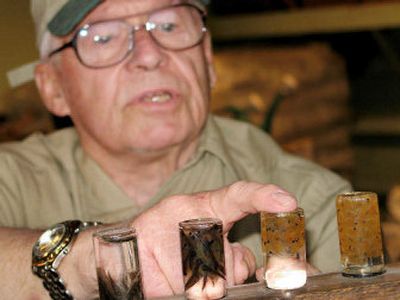See trout grow

The revival of the popular Spokane Fish Hatchery tours is no simple matter, as one could see recently while veteran tour guide Bob Bates packed facts into the brains of 17 tour-guides-in-training. “Wow,” whispered one trainee during Bates’ presentation. “There’s a lot to hatching fish.”
The hatchery, built in 1934, is operated off Waikiki Drive near St. George’s School by the Washington Department of Fish and Wildlife. Bare-bones staffing levels prevent the department’s hatchery staff from dealing with visitors.
For more than a decade, Bates has headed a group of volunteers who explain to about 1,000 visitors a year – mostly school kids – the work and wonders of producing trout for stocking in Washington’s fishing lakes.
“One of my neighbors talked me into guiding tours and I found that I really enjoyed talking to the kids and answering their questions about fish,” said Bates, 76, a veteran fly fisher.
“I also realized there was a heck of a lot I didn’t know about what goes into raising fish.”
This winter, however, the aging ranks of volunteer guides were dwindling fast.
“When we were down to five, I realized we just couldn’t do it anymore,” Bates said. “I felt terrible this spring when I had to call and cancel the 20 tours we still had on the schedule.”
Local Safari Club International members felt terrible, too, when they read the news that educational hatchery tours would no longer be available.
“We just couldn’t let that happen,” said Mike Coyle, a longtime member of the sportsmen’s group.
Within a few months, club members had rounded up the seeds for a new pool of tour guides and started raising donations for a fund to provide educational materials and pay the volunteers 41 cents a mile to cover traveling costs roundtrip to the hatchery.
“We still need more donations and volunteers to train as guides, but for now we’re rolling and scheduling more hatchery tours,” he said.
Bates said volunteer guides have to do considerable preparation, learning facts, watching a video and becoming familiar with props ranging from stuffed fish to vials of eggs in various stages of development.
“We’ve boiled down the hatchery information into a nine-page syllabus,” he said as he began giving the overview:
“Griffith Spring, which produces 9 million gallons of 51-degree water directly from the Spokane aquifer, is the foundation for the hatchery.
“The Spokane Hatchery is one of the state’s originals and remains one of the largest, producing 9 million eggs a year, or 40 percent of the rainbow trout eggs in Washington. Some browns, cutthroats and kokanee also are raised at the hatchery.
“The eggs are produced by 5,900 of the 3- and 4-year-old “broodstock” trout the hatchery keeps on hand, and every tour ends with the excitement of seeing these lunkers rise to fish food the visitors get to toss into their tank.
“Spawning at the hatchery occurs from mid-November through mid-January (an exciting time to visit the hatchery). Wild rainbows spawn in spring, but the hatchery broodstock was developed to spawn earlier so the fish could be raised for stocking in lakes.
“A 4-year-old rainbow female produces up to 5,000 eggs.
“Timing is critical in taking and handling the eggs. For 24 hours after they’ve been stripped from the female and fertilized, they can be handled and even shipped. From 24 hours to 16 days, they are too fragile to be touched as the clear, cold Griffith Spring water flows over them in special trays.
“After 16 days, about 6 million eggs are shipped to other hatcheries for hatching and distribution to waters in other regions of the state.
“The eggs are tended carefully and moved and sorted occasionally as they develop through the eye stage and begin hatching in to yoke-sac fry.
“Feeding begins 11 days after the first fry begin swimming up to the surface looking for food.
“Without hatcheries, no trout would exist in many of the region’s naturally troutless lakes.
And without hatchery tours, thousands of kids wouldn’t know any of these and other fascinating facts about fish.